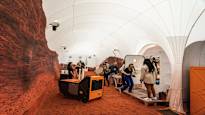The human experiment, which lasted 378 days, ended at midnight Finnish time in a happy atmosphere in Texas.
A NASA astronaut knocks three times and loudly on an unassuming door at five o’clock on a Saturday afternoon in Houston, Texas.
– Are you ready to come out? she exclaims happily.
There is no answer, but behind his mask the astronaut seems to be grinning with satisfaction as he opens the door.
Accompanied by applause and cheers, four scientists who have spent a year in a simulator without other human contacts to test how life on the planet Mars would go are revealed from behind the door.
Microbiologist Anca Selariuan engineer Ross Brockwella doctor Nathan Jones and the team leader, a biologist Kelly Haston have spent the last 378 days confined to a “Martian” habitat as part of a study by the U.S. space agency, NASA, to find out what it would take for humans to survive on the Red Planet.
The four have grown vegetables, made Mars walks and worked under extra stressors in Nasa terms. That is, they have been isolated in a closed space away from their families. The message connection to Earth has also been interrupted.
Now, however, everyone returns to Earth’s chamber radiant and visibly emotional.
– Hey. It’s really nice to be able to say hello to you, Kelly Haston laughs.
– I really hope I don’t start crying standing here in front of all of you, Nathan Jones says as he grabs the microphone.
But that’s almost what happens when he spots his wife in the crowd a moment later.
Research especially on nutrition and performance
The habitat of the researchers participating in the simulation was a 3D printed base called Mars Dune Alpha. The 160 square meter simulator had bedrooms, a gym, common areas and a vertical farm to grow food.
The covered “outside area” separated by an airlock was full of red sand, and there the team did Mars walks in spacesuits.
In particular, nutrition and its effect on human performance were studied during the experiment.
– Scientists have spent more than a year in this habitat conducting crucial research as we prepare to send humans to the Red Planet, NASA Johnson Space Center Associate Director Steve Koerner said to the crowd that came to receive the Mars explorers.
– I am very grateful.
The simulation was the first in a series of three studies planned by NASA to study crew health and performance.
Source: AFP
